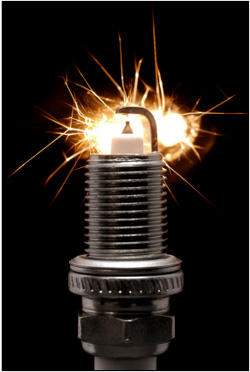
The spark plug is essentially a high-voltage “bridge” that ignites gas vapors inside your engine and makes your car go. On average, spark plugs should be replaced every 50-100,000 miles—the good news is that new spark plugs are relatively cheap and changing them is a simple process. Just follow the steps below.
Tools you’ll need:
- 3/8 inch ratchet
- 3/8 ratchet extension
- 5/8 inch socket wrench
- Spark plug socket boot
- Swivel adapter (for tight spaces)
- Compressed air can
1. In your vehicle manual, look up the details on your spark plugs: how many there are in your engine, and what type of plugs you need. Get a new set of spark plugs from an auto parts store.
2. If you’ve been driving your vehicle, open your hood and allow things to cool down for a few hours. Spark plugs are often the hottest part of the engine.
3. Open your hood and locate the park plugs on the engine, following your vehicle manual. An easy way to locate them is to follow the thick, rubbery wires under the hood, each of which leads to a spark plug on your engine. (Depending on your engine type, the spark plugs could be on top of your engine or on the sides).
4. Take one spark plug wire off one plug by grabbing the spark plug wire boot. Remove the spark plug wire by grasping the boot firmly and pulling while wiggling it. If the boot doesn’t give easily, you can use a spark plug wire puller, which can be found at the auto parts store.
5. Replace one spark plug at a time. This will avoid confusion and prevent you from matching the wrong spark plug wire to the wrong spark plug.
6. Clean away any dirt and debris from the spark plug hole you are working with—usually blowing it away with compressed air works the best.
7. Place the spark plug boot into the spark plug socket, down onto the spark plug you are removing. Turn left to loosen and remove the plug. If you are working in tight quarters, the swivel adaptor will come in handy. The spark plug should come out stuck in the rubber socket boot.
8. Put the new spark plug in. Twist it clockwise by hand first, then tighten it with the same wrench. Connect the wire back in place; it should snap on to tell you it's connected.
9. Repeat steps 4-8 for each of your other spark plugs.









